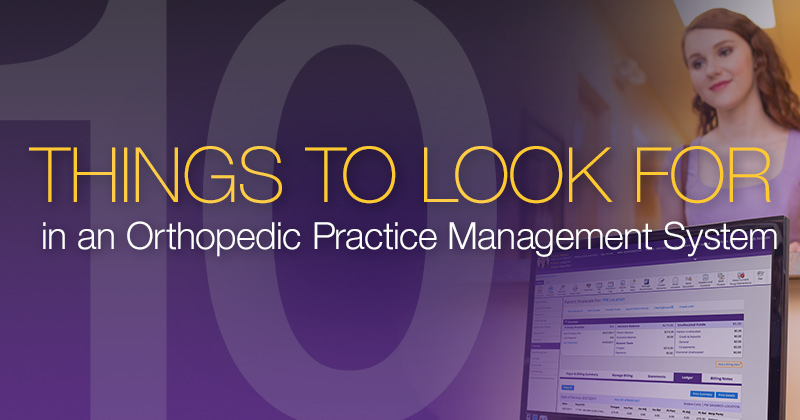10 Traits to Look for in an Orthopedic Practice Management System

Tips on how to find a solution that helps enhance the operational health of your orthopedic practice
A robust orthopedic practice management solution should allow you to more efficiently and effectively manage your office workflow and revenue cycle process by providing visibility to your practice’s financials and patient information.
Let’s check out a couple of the essential features that you should look for in orthopedic practice management software.
1. Ease of use
You and your staff are busy and there’s always more on the to-do list. What shouldn’t be on your task list is combing through patient charts for past exam notes, manually tracking the approval and payment status of numerous claims or trying to resolve denials. Your user-friendly orthopedic practice management system should have an intuitive interface that simplifies daily tasks and improves staff satisfaction. Patient data and financial information should be readily available with as few clicks as possible.
2. Seamless interface with your orthopedic electronic medical record (EMR) system
One of the main advantages of having a technology-focused practice includes the ability to enhance communication to improve workflow efficiencies. By using an orthopedic practice management solution that interfaces with your EMR system, you can streamline scheduling, check-in, check out, billing and reporting.
EMA™, Modernizing Medicine’s orthopedic EMR system, integrates directly with our Practice Management solution, providing an all-in-one solution with a single sign-on to access everything for your orthopedic practice all in one place. This will allow you to do more than just manage your practice but can help transform the clinical, financial and operational aspects of your practice from one integrated solution.
3. Financial dashboards and custom reporting
An effective orthopedic practice management system should provide digestible data to help you make intelligent business decisions regarding the financial health of your practice. Each practice has different financial goals and with the ability to view financial dashboards and create custom reports, you can focus on the key metrics to meet your practice’s needs. You should easily identify denials and unallocated charges to help maximize the financial performance of your practice.
Cortney Hill, billing manager at Connecticut Family Orthopedics, said, “Our biller and I love the reporting functionality Practice Management offers. Every Monday, we run the denial and unallocated reports to ensure money collected was posted. The denial report identifies our high-dollar claims and sorts them by oldest to newest so we don’t file in an untimely manner. We are happy to see that the turnaround time for payments is much quicker than with our previous system—payments arrive within 30 days, and we currently don’t have any outstanding payments over 90 days.”
4. Real-time insurance verification
Your staff should be able to quickly verify a patient’s insurance eligibility before their appointment starts to proactively identify any issues with insurance. This feature can help lower the risk of claims denials and speed up patient check-in. Without this functionality built-in, most orthopedic practices have to verify eligibility from a third-party website. Your practice management solution should eliminate this additional step in an effort to make your practice more efficient.
5. Automated coding and orthopedic billing
The revenue cycle process is complex and can be difficult to navigate even with the most experienced staff. Your practice management system should help guide you along every step of the way to ensure your orthopedic billing process runs smoothly to help maximize financial performance. EMA suggests ICD-10, CPT and modifier codes based on the provider’s documentation during the patient’s exam, and these codes transfer seamlessly to the practice management system. This may help improve billing accuracy and the front desk can see what the patient owes during check out. Claims are electronically submitted every few hours allowing for faster claims processing and providing the most current financial information.
6. Claims scrubbing prior to submission
Before claims submissions your practice management system should have a built-in process to analyze each claim to help catch some potential issues before submission to the payer. Additionally, you should have the flexibility to create custom payer rules for your practice. This check will assist in ensuring claims go out clean on the first submission and help reduce the risk of denials—expediting the turnaround time on payments.
7. Easy appointment scheduling
With your provider’s busy schedules, finding and booking an appointment for patients can prove quite challenging. With a user-friendly, orthopedic practice management system, you should have the ability to filter your search by provider, appointment type, duration and time frame to easily identify available appointment slots and eliminate hunt-and-peck scheduling. Additionally, you should be able to quickly indicate the reason for the visit and add any appointment notes.
8. Ability to accept patient payments
Your orthopedic practice management software should provide a way to easily collect credit card payment without having to enter information manually. Using a PCI-compliant merchant service solution allows you to process payments with a credit card reader or Apple Pay and store the payment information so the patient doesn’t have to present their credit card every time. It should also allow for receipts to be emailed and provide the ability to refund transactions if needed. The system should also keep an audit log of all transactions for fraud prevention.
9. Enhanced communication across the practice
An advanced practice management system should provide better communication between your front office staff and clinical providers. With an intramail messaging feature you can communicate in real time to answer patient questions and help prevent delays in the revenue cycle process.
Additionally, a mobile phone app, such as PocketEMA™, allows providers to view their schedule and patient data from nearly anywhere at any time. At a glance, you can find out where you need to be and when, plus use your phone to compose notes, answer staff or patient messages, create tasks and more.
10. Exceptional customer support
In addition to evaluating the technical features and functionality of an orthopedic practice management system, you should also look at the vendor’s technical and customer support. A great practice management support team should include experienced orthopedic billing staff who can answer your questions and support the needs of your orthopedic practice.
Patsy Smith, practice manager at South Palm Orthopedics, shared, “I can’t say it enough: The Modernizing Medicine team is great. Any time I have a question, someone provides me with the answer. I never hesitate to tell others, ‘You should consider Modernizing Medicine if you want a company that works with you.’”
The important decision of choosing the right orthopedic practice management system can support the overall health of your practice. When doing your research, looking for these key traits should help guide you to a solution that will help improve the operational aspects of your orthopedic practice.





